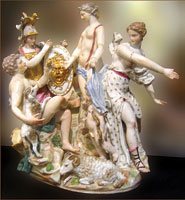“Greek myths endure,” says Buxton, “because however different ancient Greek society was from those that followed, there was always sufficient common ground, in terms of the issues and dilemmas that life presents us with, to enable people who came later to relate to the stories. For instance, when Ted Hughes’s Tales from Ovid came out in the late 1990s, it was a phenomenal best seller. The tales he translated were an Ovidian retelling of Greek myths for a Roman audience, but still they resonated with, and spoke to, people of the late 20th century.”
All these classical myths have now been captured in a monumental, 40-year, international project of which Buxton has been president since 2006. It is known as the Lexicon Iconographicum Mythologiae Classicae (LIMC). The idea was initiated in 1969 by Professor Lily Kahil, the wife of Boutros Boutros-Ghali. Kahil recognised that scholars working in the fields of ancient myth, ancient religion and even modern art required a tool to help with their research: a repository where all the representations of the classical myths could reside. Take Achilles: a classical scholar can now find in the Lexicon all the images in which he was represented; see where they came from and where they are located now; how they were divided between vase paintings, sculptures and wall frescos; what the motifs were, and how these depictions have developed over time; plus a wealth of other valuable information.
Initially, Kahil’s ideas were ridiculed – it would be such a massive undertaking that sceptics believed it could never be accomplished – but she persevered and translated the idea into reality. In 1981, the first volume was published, comprising half of the entries for the letter ‘A’. No fewer than 87 authors contributed to this volume alone. Eighteen years later, in 1999, this remarkable project was effectively complete. Having become a worldwide collaboration by that time – altogether, 33 countries are involved – the finished work comprised 18 volumes, each of which consists of a volume of plates and an accompanying volume of text. A further ten years down the line and another two volumes (Supplementum 2009) have been added. These depict many new and hitherto unpublished representations of myths and bring the entire 40-year project up to date.
But the work doesn’t stop there. The LIMC Foundation has two major ongoing projects. The first, ThesCRA (Thesaurus Cultus et Rituum Antiquorum), documents ancient cults and rites; five volumes have been published so far with three more on the way. The second involves digitising all the images in the Lexicon, so as to put it online – and make it free to the user. Furthermore, what they plan to put online is not only the images that appear in the Lexicon, but the whole archive from which they were taken. In other words, if, worldwide, there are 3,000 images of Heracles slaying the Nemean lion, only a fraction of which could be illustrated in the Lexicon, the objective will be to put them all online. In spite of this huge task, and despite the increasingly challenging job of raising funds in today’s financial climate, Buxton anticipates that both ThesCRA and the digitisation project will be completed within three years.
Buxton uses the idea of astonishment to investigate the extent to which the ancient Greeks took these myths seriously
Alongside all of this, Buxton continues his own research. His authoritative and influential book, The Complete World of Greek Mythology, has been translated into nine languages, including Japanese and modern Greek. The book discusses the origins of Greek mythology, examines the Greek landscape and its significance in the development of the narratives, and comes full circle with a concluding chapter on Greek myths after the Greeks, from Roman adaptations to modern transformations. It has become a classic example of a work which maintains scholarly rigour while engaging the interest of a broad public. His latest book, just published by Oxford University Press, is called Forms of Astonishment. This work sets out to interpret a number of Greek myths that narrate the transformations of humans and gods. “The Greek word θάμβος [thambos] means astonishment,” explains Buxton, “and is often found in stories about people being transformed into things that bystanders were astonished by, and about gods turning into shapes that were not anthropomorphic, such as Daphne turning into a laurel tree.”
Buxton uses the idea of astonishment to investigate the extent to which the ancient Greeks themselves would have found such transformations strange; in other words, how seriously did they take these myths? This leads him to enquire into the role of things turning into other things in our own world, and to ask if we can retain a residual feeling of astonishment at the same time as intellectually understanding the processes involved. He thinks we can: “We can be astonished every time a butterfly emerges from a cocoon, while recognising the biology that underlies its metamorphosis.” The book raises issues relevant to an understanding of broad aspects of Greek culture and in doing so it also illuminates issues explored by anthropologists and students of religion, thereby confirming the legacy and relevance of the Greek myths today.

